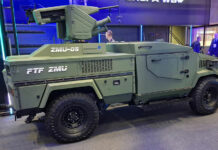Boeing [NYSE: BA] and the U.S. Air Force carried out the first test in a series of demonstrations evaluating the use of near-space airborne platform providing theater-wide information broker services, dispatching real-time tactical communications and information to ground forces. The series, dubbed Project Marti, will integrate persistent, High-Altitude, Long Endurance (HALE) concept vehicles, acting as communications relay and hub, communicating between unmanned air systems operating at lower altitude, and users across the theater. The links will span over a large geographic region, beyond the reach of a single low-altitude asset, without the need for expensive space-based assets that are often reserved for higher priority missions.
“The challenge here is much more than just the establishment of a high-altitude communications relay,” said Patrick Stokes, Boeing Phantom Works manager of Network-Centric Operations-related programs. “It’s really all about effectively bringing the power of real-time information to bear within a tactical theater, and doing so without the need for an expensive, fixed infrastructure.”
To bring this communication power to the troops, Project Marti is leveraging the latest information management brokering techniques, to provide advanced publish and subscribe capabilities across a broad geographical region. In a recent risk reduction evaluation, simulated UAV sensors delivered imagery and embedded data in ‘near real-time’ through an Internet Protocol network to an airborne information broker placed in a high altitude balloon acting as a surrogate for a near-space vehicle.
The sources transmitted the data simultaneously in a Cursor-on-Target format that allows accurate tactical information to be passed more efficiently among multiple systems. The information broker then successfully distributed to ground stations only the data that matched users’ subscriptions. This concept enables multiple sensors to be shared by many users, thus optimizing the utilization and availability of sensors. “The subscribers need only display the data that’s relevant to their tactical missions, much in the way that an Internet user would employ a search engine to obtain relevant information.” said Dr. Jim Paunicka, Phantom Works principal investigator on Project Marti.
The tests will culminate next year (early 2008) in flight demonstration involving multiple airborne and near-space assets operating over an extended range to support a large number of ground units. Live imagery and tactical data acquired by unmanned aerial systems’ sensors operating at medium and low altitudes will be published through information broker to a balloon, acting as a network node, deployed to near space elevation of 80,000 feet. Ground units will be able to collaborate with each other by subscribing to data relevant to their respective missions.



















